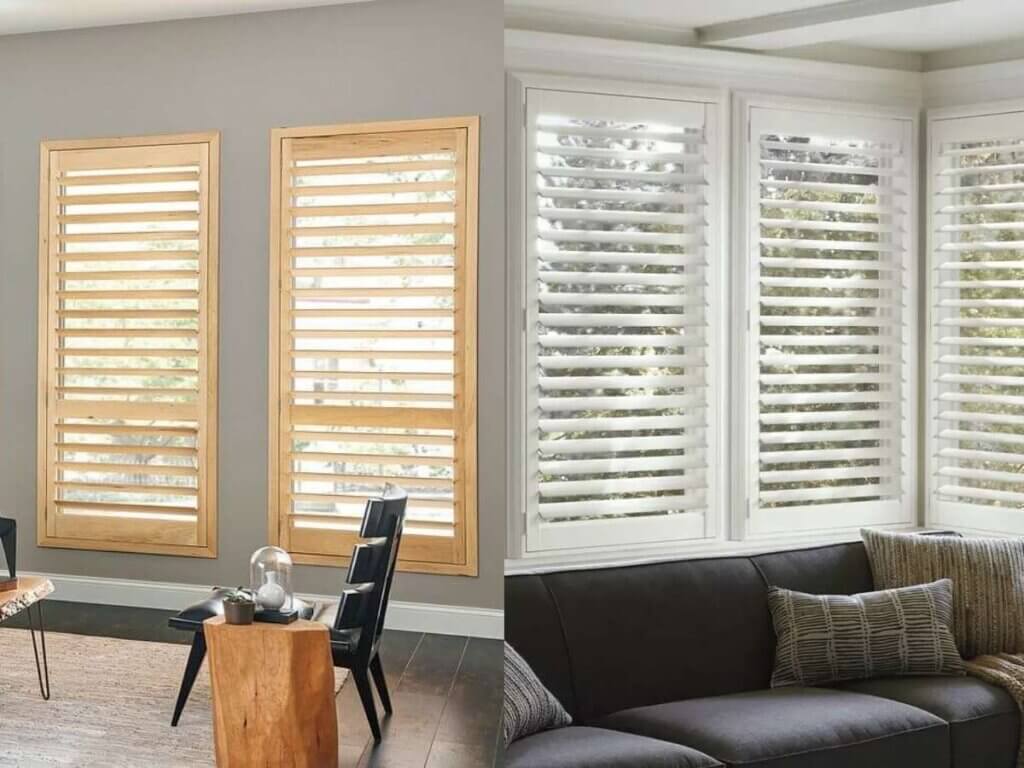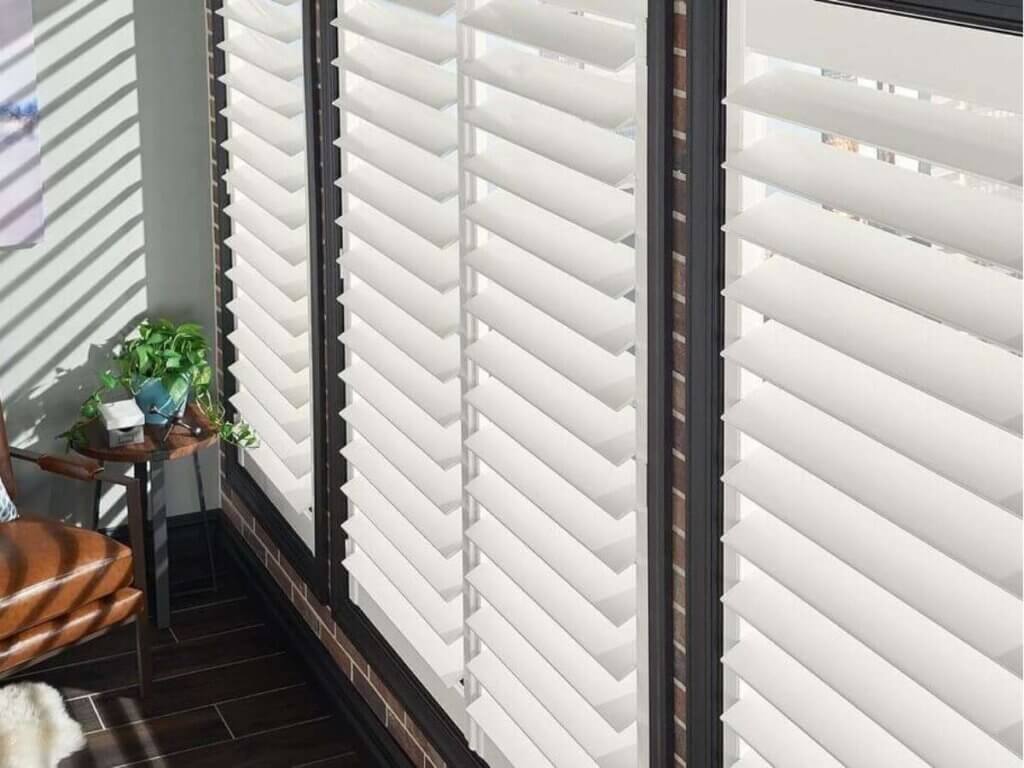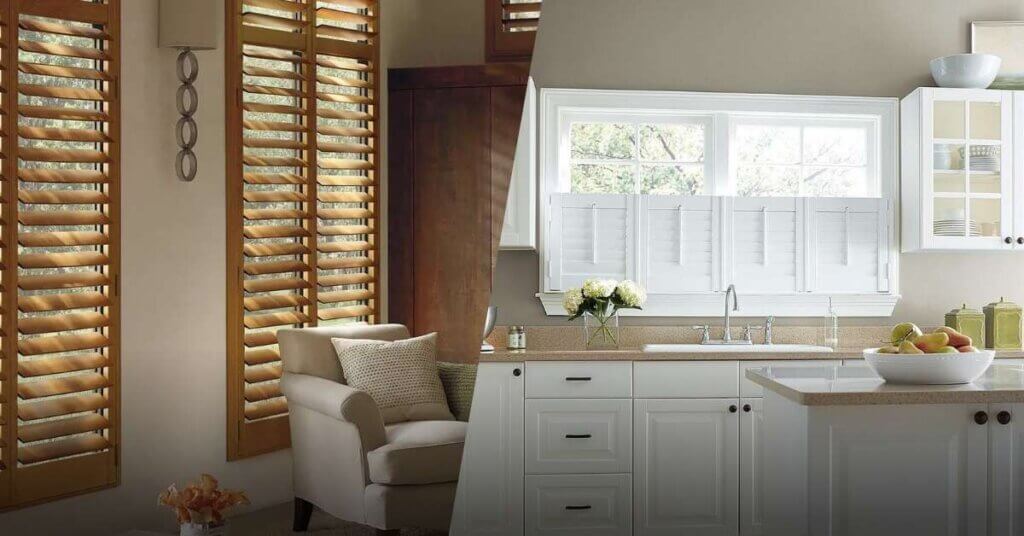Shutters come in a range of materials, from PVC and composite blends to solid wood. While there’s no shortage of options, wood and composite shutters are often the two most debated choices among homeowners.
If you’re weighing the timeless charm of real wood against the practicality of composite, this guide is for you. We’ll take a close look at how these two materials stack up in terms of cost, durability, and maintenance—so you can confidently choose the right fit for your home.
What Sets Wood and Composite Shutters Apart?

Let’s look at material makeup and aesthetics of wood versus composite shutters.
Material Makeup
- Wood shutters are crafted from premium basswood, poplar, or other lightweight hardwoods prized for tight grain and paint- or stain-ready surfaces.
- Composite shutters (faux-wood or engineered wood) blend hardwood core or MDF with PVC or polypropylene wrap. This hybrid resists moisture and everyday wear.
Aesthetics
Natural timber offers depth, character, and limitless stain colors—perfect for traditional interiors or homes celebrating natural materials. Composite lines mimic that grain so closely that only close inspection (or your installer’s invoice) reveals the difference. For bright whites that never yellow, composite has the edge.
Cost Comparison: Wood vs Composite Shutters
Let’s evaluate the up-front price against the long-term value of wood and composite shutters.
|
Field of Comparison |
Wood Shutters |
Composite Shutters |
|
Initial Cost |
Higher—premium material and craftsmanship |
Lower on average |
|
Durability and Lifespan |
20–30 years with proper care |
25+ years; impervious to most day-to-day damage |
|
Maintenance Needs |
Repainting/refinishing every 8–10 years |
Occasional tightening of hardware |
|
Moisture Resistance |
Moderate; may warp in baths or basements |
Excellent—ideal for high-humidity rooms |
|
Aesthetic Options |
Any stain or custom finish |
Less versatile; typically available in whites and neutrals |
Bottom line: Wood commands a higher entry price but brings unmatched custom finishes. Composite saves upfront and shrugs off moisture, trimming lifetime maintenance costs.
Durability in St. Louis Conditions
Temperature and Humidity Swings
St. Louis summers get steamy while winters dip below freezing. Those extremes cause natural wood fibers to expand and contract; left unsealed, louvers can bow or crack. Composite’s polymer shell blocks moisture, making it highly warp- and crack-resistant—a plus for kitchens, baths, and south-facing windows.
Fading and Color Retention
Modern UV-cured paints protect both materials, but composite’s vinyl or polypropylene finish is inherently color-fast. Wood needs periodic re-staining to keep rich tones vibrant—something to factor into long-term upkeep.
Energy Efficiency and Insulation
Both shutter materials create a still air pocket that boosts insulation, lowering HVAC load in Midwestern heat waves or cold snaps. A tight installation—not the material itself—has the bigger impact here, so professional fitting is key.

Maintenance Comparison
Routine Cleaning
- Wood: Dust with a microfiber cloth; wipe spills quickly to prevent water marks.
- Composite: Same dusting routine plus the freedom to swipe with a damp cloth—no risk of swelling.
Long-Term Upkeep
Wood shutters reward care with decades of service but may need touch-ups or a fresh coat of paint every decade. Composite shutters rarely require more than hardware tightening, making them attractive for busy households that value low-effort living.
Key Takeaways
- Budget: Composite shutters typically cost 10–25% less than natural wood without sacrificing curb appeal.
- Durability: The composite’s moisture resistance wins in humid or splash-prone rooms. Wood excels in dry, climate-controlled spaces.
- Maintenance: Wood demands occasional refinishing; composite offers wipe-clean convenience.
- Aesthetics: Choose wood for bespoke stains and deep grain; choose composite for crisp, maintenance-free whites.
- Long-Term Value: Both last decades, but savings differ—wood adds premium resale appeal, while composite saves on upkeep.
Frequently Asked Questions (FAQs) About Wood Versus Composite Shutters
1. Which shutter material is best for high-humidity rooms like bathrooms?
Composite shutters. Their PVC or polypropylene exterior resists swelling, warping, and paint peeling even when steam builds up.
2. Can wood or composite shutters be custom-made to fit specialty windows?
Yes. Both wood and composite shutters can be customized to fit arches, angles, and other unique window shapes. However, wood offers greater flexibility for intricate designs and specialty finishes, while composite options may be more limited in shape and color variety.
3. Do wood shutters boost resale value more than composite?
Many buyers associate real wood with premium craftsmanship and may pay a slight premium. However, after years of use, a composite’s sleek condition can be just as compelling, especially if moisture damage would have dulled wood’s finish.
Book a Visit to Explore Shutter Options Up Close
We bring high-end natural wood and advanced composite shutters to your home. Explore textures, louver sizes, and finishes under your lighting, then let our experts measure and install for a perfect, energy-efficient fit.
Request your free in-home consultation today with Made in the Shade St. Louis and see which material fits your windows and lifestyle.


